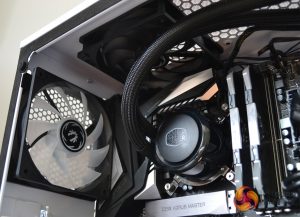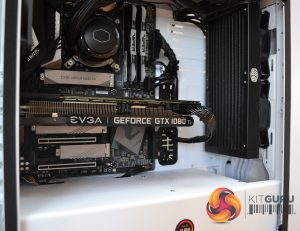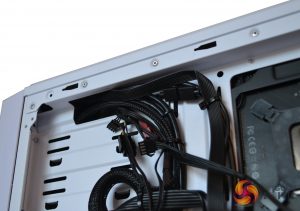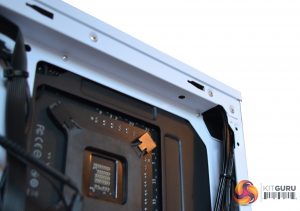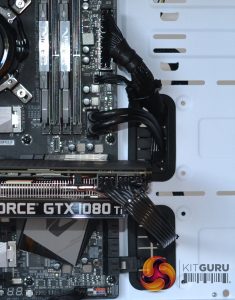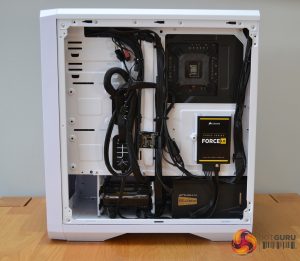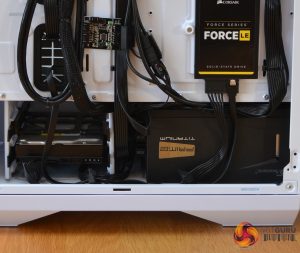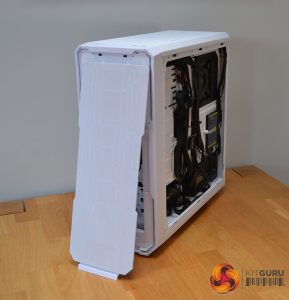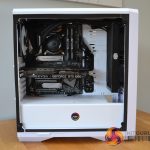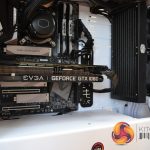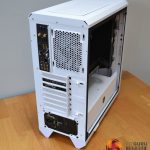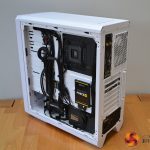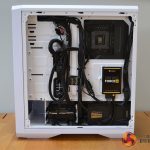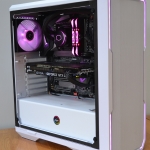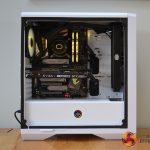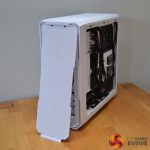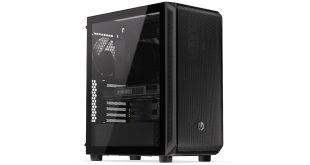Removing the side and front panels gives you access to everything needed to build your system. The case came with two 120mm fans but, annoyingly, they are not identical. The fan fitted to the rear exhaust has a black frame with opaque fan blades and has RGB lighting – but the front fan is all black with no RGB lighting.
This may not be a problem for some, but we had to move the front fan to the top of the case, so we could mount a 240mm All-In-One CPU cooler at the front, therefore ending up with two different looking fans very close together. The reason for this could possibly be to save costs as RGB LED fans will no doubt be more expensive to manufacture.
While on the subject of cooling, the only place you can mount a large radiator in the Enso Mesh is at the front. There is barely enough room to fit a 120mm fan at the top of the case as it’s so close to the motherboard EPS power connectors. Even the slimmest radiator would not fit here. There is, however, room at the front to fit either a 240mm, 280mm or 360mm long radiator, with a maximum thickness of 35mm. You could also add a 120mm radiator or All-In-One cooler on the rear exhaust mounting point.
CPU coolers up to a 160mm tall can be fitted in the Enso mesh, so it may be tight fitting a large air cooler such as the Be Quiet Dark Rock Pro 4 or the Noctua NH-D15, especially if you have tall RAM and need to mount the fan higher up for clearance.
For those who take cable management seriously, you will not be happy to hear there is a slight lack of cable management cut outs. The areas we found lacking and most disappointing was at the top of the motherboard, near the centre where CPU fan cables are usually routed. The only cut-outs at the top were in the far right and left hand corners, which makes CPU fan cables difficult to hide.
Another area was the 24-pin power cable – the cut out was quite a way below the 24-pin socket, so we could not run the cables straight from the socket into a cut-out and therefore had to angle them down. BitFenix could have implemented these cut-outs very easily which would have made the build look neater.
There is, however, enough cable tie down points behind the motherboard tray to make a reasonably tidy job of cable management, and a healthy 23mm recess between the motherboard tray and side panel is enough space to fit the cables without deforming the side panel once reinstalled.
By far, the worst design flaw of the BitFenix Enso Mesh is the layout of the power supply and 3.5” drive bays. They are so close together it makes fitting the power supply extremely difficult. At one point, we almost gave up fitting the Seasonic power supply, as it was so tight to slide in through the gap you had to physically bend the cables at right angles to fit the power supply in place. The positioning of the 3.5” drive bays and the fact the power supply shroud could not be removed, made it impossible to plug any extra cables in after fitting the power supply, so you must make sure you plug all your cables in first.
If BitFenix had designed the power supply mounting so it was installed from the rear, rather than the side, it would have resolved this issue, while making installing extra cables to the power supply at a later date far more simple.
Build Gallery
Other than the issues highlighted, building a system into the Enso Mesh is pretty straight forward. We were impressed that there was ample space for a full-size GPU, a good amount of cable management tie down points on the rear of the motherboard tray and a sufficient amount of space for storage devices. With the lack of optical drive bays at the front, it leaves you with plenty of room for fitting an All-In-One cooler and creates a spacious feel to the build.
 KitGuru KitGuru.net – Tech News | Hardware News | Hardware Reviews | IOS | Mobile | Gaming | Graphics Cards
KitGuru KitGuru.net – Tech News | Hardware News | Hardware Reviews | IOS | Mobile | Gaming | Graphics Cards


